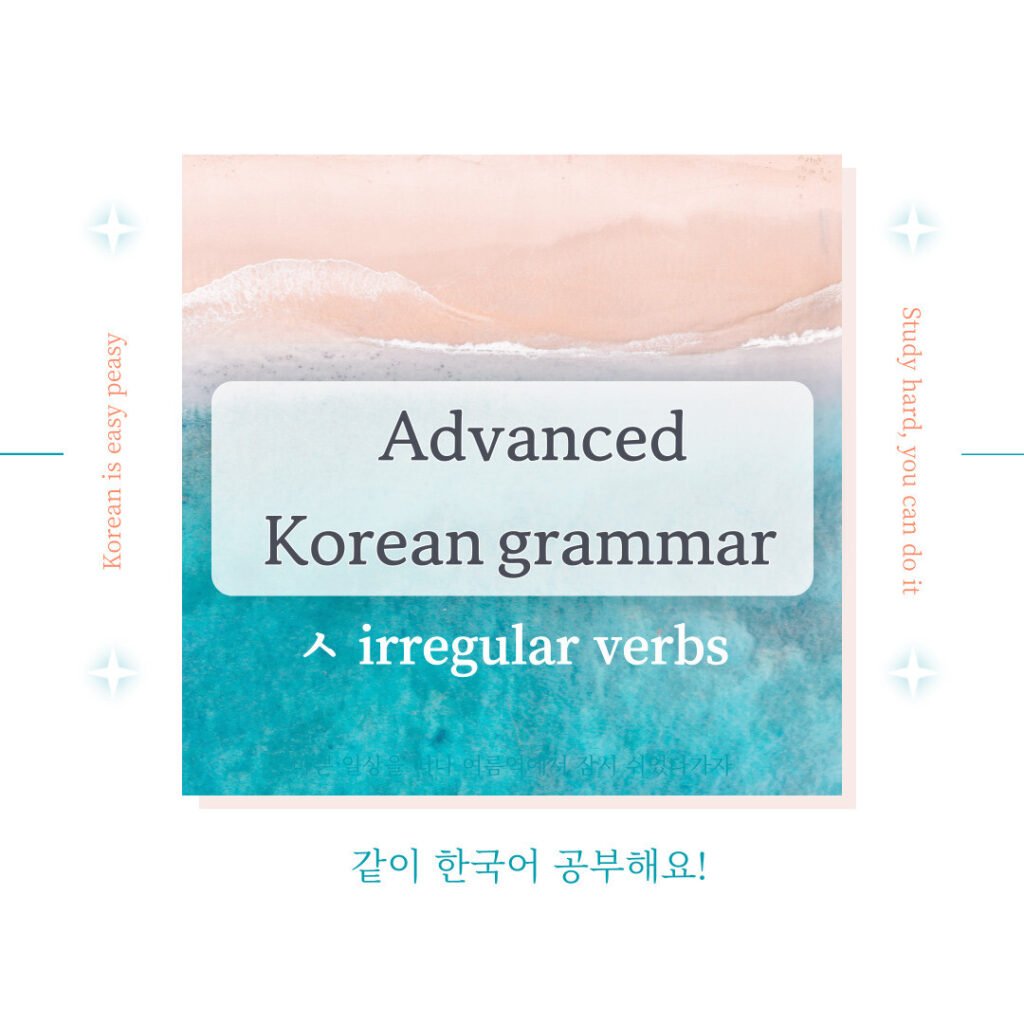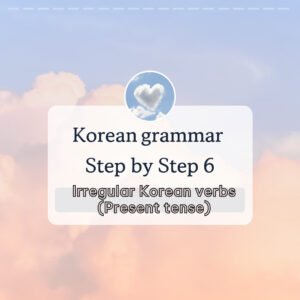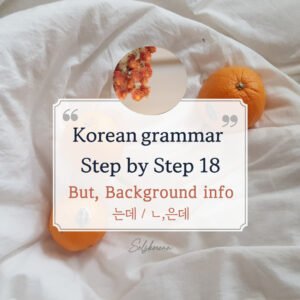‘ㅅ’ irregular verbs in Korean(낫다, 짓다) with regular ones!
Hello language learners!
In this post, I will cover one of the Korean irregular verbs, the “ㅅ” irregularity. Along with “ㄷ” irregular verbs, there are some verbs ending in the ㅅ batchim that change form depending on the suffix, but not many. The most commonly used ones are only around five verbs.
So, let’s delve into this topic and explore these verbs and their conjugations in detail.
Let’s grasp the concept of grammar
Understanding “ㅅ” Irregular Verbs
“ㅅ” irregular verbs are verbs whose stems end with the consonant “ㅅ”.
When conjugating these verbs, the final “ㅅ” can behave irregularly depending on the suffix it combines with.
Here are the key rules:
Rule #1: Vowel-Suffix Combination
When conjugated with a suffix that starts with a vowel (e.g., 아요/어요 for present tense, 었어요/았어요 for past tense, 을 거예요 for future tense), the final “ㅅ” is dropped from the verb stem.
낫다 (to get better) → 나아요 (gets better)
나았어요 (got better) / 나을 거예요(will get better) / 나아야 해요(have to get better)
긋다 (to draw a line) → 그어요 (I draw)
그었어요 (drew) / 그을 거예요(will draw) / 그어야 해요(have to draw)
짓다 (to build) → 지어요 (I build)
지었어요 (built) / 지을 거예요(will build) / 지어야 해요(have to build)
붓다 (to swell, pour) → 부어요 (I pour)
부었어요 (it’s swollen / poured) / 부을 거예요(will swell/pour) / 부어야 해요(have to swell/pour)
Rule #2: Consonant-Suffix Combination
When conjugating with a suffix that starts with a consonant (e.g., 고 있어요 for progressive tense), the final “ㅅ” remains unchanged in the verb stem.
낫다 (to get better) → 낫고 있어요 (getting better)
낫는 중이에요 (getting better) / 낫고 싶어요(want to get better)
긋다 (to draw a line) → 긋고 있어요 (am drawing)
긋는 중이에요 (am drawing) / 긋고 싶어요(want to draw)
짓다 (to build) → 짓고 있어요 (am building)
짓는 중이에요(am building) / 짓고 싶어요(want to build)
붓다 (to swell, pour) → 붓고 있어요 (am pouring)
붓는 중이에요(am pouring) / 붓고 싶어요(want to pour)
Common “ㅅ” Irregular Verbs
Here are some common “ㅅ” irregular verbs and their conjugated forms:
잇다 (to connect) → 이어요 (present tense)
낫다 (to be cured/to be better) → 나아요
붓다 (to swell/to pour) → 부어요
짓다 (to build) → 지어요
긋다 (to draw a line) → 그어요
젓다 (to stir/to whip) → 저어요
Let’s look at how it’s used in sentences!
(1) 우리는 두 점을 이을 거예요: We will connect the two points.
(두 점: two points 잇다: connect)
(2) 빨리 나으세요!: Get well soon!
(빨리: soon 낫다: to get better (으)세요: making a suggestion conjugation)
(3) 어제 울어서 얼굴이 부었어요: My face is swollen because I cried yesterday.
(울다: cry 얼굴: face 아/어/해서 : because 붓다: to get swollen)
(4) 종이에 선을 그으세요: Please draw a line on the paper.
(종이: paper 선: line 긋다: draw (으)세요: making a suggestion conjugation)
(5) 요리를 할 때 소스를 잘 저어야 해요: You need to stir the sauce well when cooking.
(요리하다: cook 때: when 소스: sauce 잘: well 젓다: stir 어/아/야해요: have to)
Note that NOT ALL “ㅅ” verbs are irregular. These are similar to the “ㄷ” irregulars!
Only few are irregulars, so I recommend you memorize these irregular ones.
Then, let’s take a look at regular ones!
Regular “ㅅ” Ending Verbs
These verbs follow standard conjugation rules without irregularities.
웃다 (to laugh) → 웃어요 (present tense)
씻다 (to wash up) → 씻어요 (present tense)
벗다 (to take off) → 벗어요 (present tense)
솟다 (to rise) → 솟아요 (present tense)
뺏다 (to steal, take by force) → 뺏어요
Let’s look at how it’s used in sentences!
(1) 우리는 그 이야기를 듣고 크게 웃었어요We laughed loudly after hearing that story.
(이야기: story 듣다: hear 크게: loudly 웃다: smile, laugh)
(2) 밥 먹기 전에 손을 씻으세요.
Wash your hands before eating.
(밥: meal 기 전: before 손: hands 씻다: wash (으)세요: making a suggestion conjugation)
(3) 실내에 들어가면 신발을 벗어야 해요. You must take off your shoes when entering indoors.
(실내: indoors 들어가다: enter 신발: shoes 벗다: take off 어/아/야 해요: must)
(4) 태양이 솟아오르고 있어요.
The sun is rising.
(태양: sun 솟다: rise 고 있다: progressive tense)
(5) 돈을 뺏는 건 나빠요.
Taking money by force is bad.
(돈: money 뺏다: take by force 나쁘다: be bad)
Summary
To internalize these rules and examples, practice conjugating both “ㅅ” irregular verbs and regular “ㅅ” ending verbs with different endings like 아요/어요, 고 있어요, and 지 않아요. Regular practice will strengthen your grasp of Korean grammar and enhance your conversational skills. And as I mentioned before, I recommend memorizing the irregular ones!
Embrace these rules, practice consistently, and watch your language proficiency grow!

If you want to book a lesson with me, click here!
If you want to improve your listening skills, check it out here!
Come visit my Youtube channel as well!





